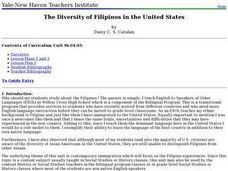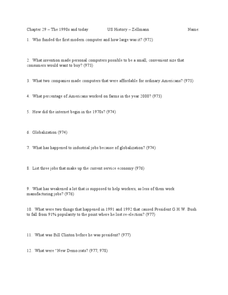Curated OER
The Diversity of Filipinos in the United States
ELLs are introduced to the experiences of Filipino immigrants to the United States. As a class, they discuss the various waves of immigration to the United States and state the reasons why they would leave the Philippines. They compare...
Curated OER
Latin America and United States Policy Today
Students compare the situation of Latin American immigrants with the situation of immigrants from other areas of the world. They use media to obtain information on topics of academic interest, personal interest, and intellectual interest.
City University of New York
Electoral College
A presidential election is a lot like the 2004 World Series, and it's also a lot like choosing an orange in a paper bag. Apply the process of the electoral college to these two analogies with a set of lessons about government...
Stanford University
Civil Rights or Human Rights?
Young citizens consider the American civil rights movement as part of the global struggle for human rights. After using a timeline activity to learn about the major events in the civil rights movement, class members study...
Curated OER
How Has Technology Affected the Presidential Election Process in the U.S.?
Students measure technological advancements as they consider how they impacted the election process in the United States. In this presidential politics lesson, students research technological changes since the 1900's and create...
Curated OER
Do Factions Control Political Parties Today?
Students establish how the first political parties were formed. In this U.S. History lesson plan, students work in groups to share their personal viewpoint on various topics provided by the teacher, then they are assigned to bring...
Curated OER
Intervene or Interfere?
Learners research the motives, actions, and results of U.S. intervention in foreign affairs between the 1961 Bay of Pigs invasion and the 2003 invasion of Iraq.
Curated OER
Political Issues and Opinions
The emergent adults in your US Government class can become informed, self-aware voters. This activity enables them to form an opinion about particular political issues then identify themselves on the political spectrum. Informed and...
Curated OER
History of Change
Students research the history of Liberia to foster a better understanding of the current situation and reflect on the role of the United States as peacekeeper there.
Curated OER
National Road to Indiana
Learners explore the National Road to Indiana. In this U.S. highway history and primary source research lesson, students read an original journal written by Jane Voorhees Lewis in 1806 describing her trip west on the first federally...
Curated OER
Symbols on Coins: U.S. Coins Evolved from Ancient Times
Learners explore the evolution of coins, and create their own coin, using the various features that have been carried over into modern times.
University of Arkansas
Our Responsibilities
The fourth in a five-lesson unit examining human rights and personal responsibility asks class groups to investigate a current rights issue, and using the provided graphic organizer, summarize the issue, consider which rights are being...
Advocates for Human Rights
Nativism and Myths about Immigrants
Where do anti-immigrants myths come from, and how can they be refuted? Learners critically analyze media reports and how to identify reliable sources. After studying a timeline that details the history of US nativism, groups research the...
Curated OER
Kansas Crops: From Seeds to Food
First graders explore U.S. geography by researching food production. In this agriculture lesson, 1st graders identify the process of crops from a seed to a plate and discuss the importance of farmers in the production of such crops....
Curated OER
Defense Mechanisms
Students examine the Cold War roots of the recent debate over the construction of United States and Russian missile defense shields. They begin by reading and discussing the article, Putin Says Russia Would Counter U.S. Shield.
Curated OER
Navigating the Straits
Learners research the players and events that have influenced U.S.-China relations since World War II, with specific emphasis on the two countries' relationships with Taiwan. They write a briefing paper, advising the president on the...
Curated OER
Ancient Mesopotamia
In this geography instructional activity, students read about ancient Mesopotamia and respond to five short answer questions that follow. They identify what part of the country was the heart of Mesopotamia. Then students compare the...
Curated OER
President for a Day
Students explore the duties of the US President. In this history lesson plan, students use research to gain information about presidents. Students utilize various forms of research, pictures, library books, textbooks, newspaper,...
Curated OER
Reforming Wall Street & its Booms, Bubbles & Busts
Students examine Wall Street Reform. In this current events lesson, students read the provided articles "Why a Financial Crisis?," "Deception and Leadership Failure=Boom, Bubble, Burst," and "How Can a Future Financial Crisis be...
Curated OER
Gary's Changing Face
Pupils investigate the history of Gary, Indiana by looking at its history, demographics and points of interest. They create a timeline of important events in the city's history.
Anti-Defamation League
Soccer, Salaries and Sexism
Call it soccer, call it football, but call it unfair! the US women's soccer team has called out the US Soccer Federation for unfair treatment in terms of salaries, support, and working conditions in a lawsuit filed in 2019. Young...
Smithsonian Institution
Korean War
North and South Korea: two regions divided. The story of the Korean War describes the events that occurred when these two regions' ideologies clashed. The resource uses various images and descriptions of artifacts, in addition to...
Curated OER
Chapter 29 – The 1990s and Today
For this 1990s America worksheet, students read assigned textbook pages about the time period and respond to 49 short answer questions.
Curated OER
Mystery State #46
In this United States mystery worksheet, students determine which state is described by the 5 clues listed on the sheet and then mark it on the outline map of the United States.























